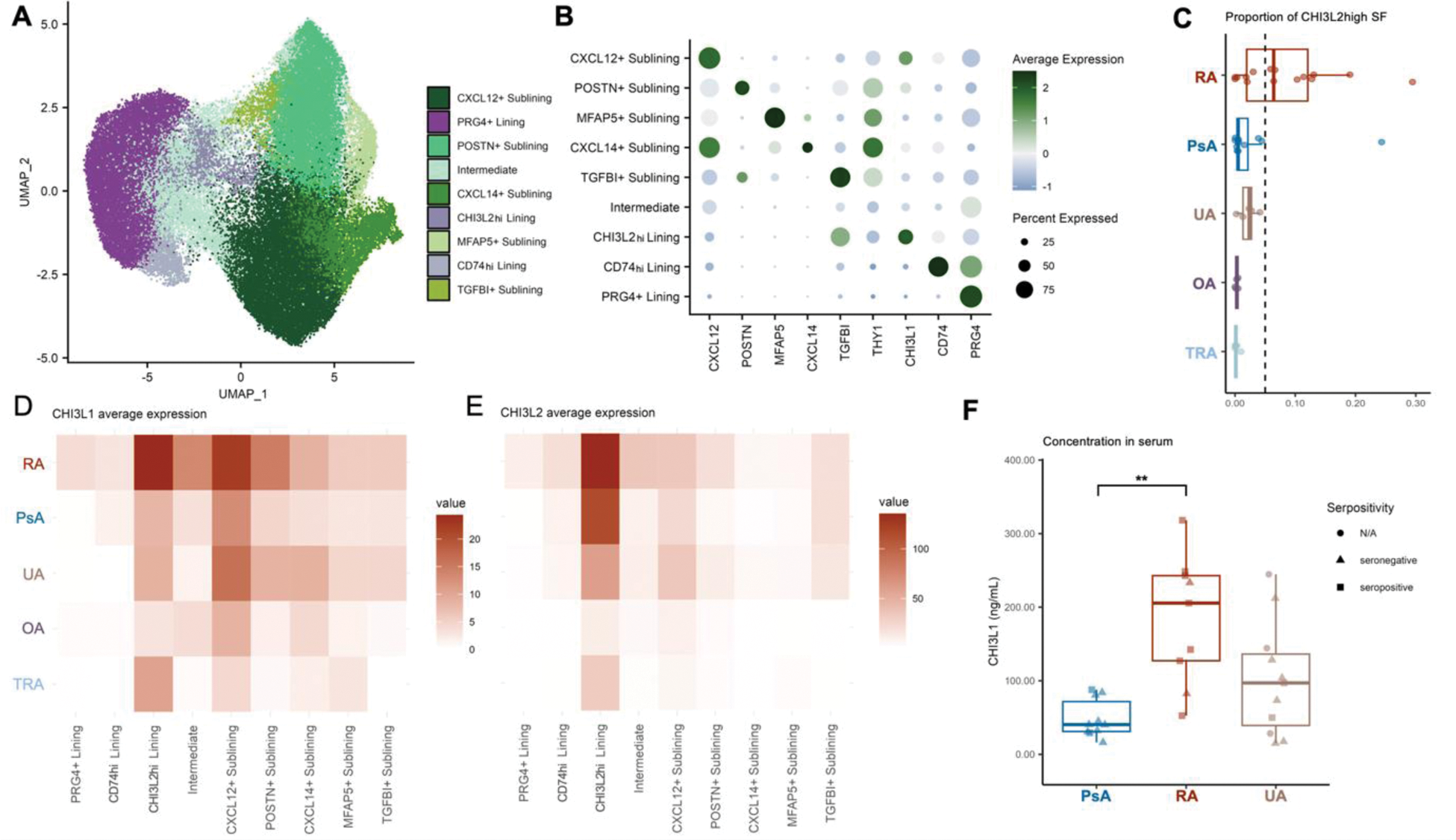

Background: Chronic inflammatory joint diseases are often difficult to diagnose due to their overlapping clinical presentations and lack of specific diagnostic tests. Distinguishing rheumatoid arthritis (RA) from psoriatic arthritis (PsA) or undifferentiated arthritis (UA) is crucial because of their different underlying pathogenic mechanisms and therefore distinct therapeutic strategies. Serological markers, such as Rheumatoid factor (RF) and Cyclic citrullinated peptide antibodies (anti-CCP), has been pivotal in diagnosing RA. However, approximately 5% of PsA patients are seropositive for anti-CCP, while approximately 20% of RA patients remain seronegative for both RF and anti-CCP. This underscores the need for additional disease-specific biomarkers.
Objectives: This study aimed to identify and characterize biomarkers for RA, allowing RA differential diagnosis.
Methods: Synovial tissue was obtained by ultrasound-guided synovial biopsy from inflamed joints of 15 patients with RA, 12 patients with PsA, five patients with undifferentiated arthritis (UA) and five patients with osteoarthritis (OA). Six synovial tissues of patients with traumatic injuries without inflammatory arthritis were used as healthy controls (TRA) (Table 1).
180,473 cells were merged for scRNA-seq analysis (mean of 4,197 cells after QC per patient). Synovial fibroblast (SF) population was identified based on known marker genes (COL1A1, THY1, PRG4, etc.) and comprised the most abundant population in the synovium (mean abundance 29.8% (±17.5)). SF were integrated using STACAS.
Results: Nine SF subpopulations were identified – three subpopulations of lining SF (PRG4+, CD74high and CHI3L2high), five sublining (CXCL12+, POSTN+, MFAP5+, CXCL14+ and TGFBI+) and one subpopulation of intermediate SF (expressing PRG4, THY1, APOE) (Figure 1A,B). Patients with RA had higher proportion of CHI3L2high SF than patients with other diagnosis and healthy controls (mean proportion RA = 8.1% (±8.2) vs other = 1.9% (±4.6%)). Nine out of 15 patients with RA had more than 5% of CHI3L1high SF compared to only one out of 12 with PsA and none of the patients with other diagnosis (Figure 1C). The proportion did not correlate with any clinical characteristics. Analysis of differentially expressed genes showed CHI3L1 and CHI3L2 had significantly higher expression in RA comparing to other types of inflammatory arthritis and healthy controls (p-value adjusted < 0.0001). Both CHI3L1 and CHI3L2 expression was the highest in CHI3L2high SF, nevertheless CHI3L1 was also expressed in other SF subpopulations (Figure 1D,E), but not in other cell types. There was a strong positive correlation between CHI3L1 and CHI3L2 expression (R=0.73, p-value<0.0001). We found no significant differences in expression of CHI3L1 and CHI3L2 between seropositive and seronegative patients with RA and no correlation with other clinical characteristics. Analysis of CHI3L1 expression in an additional scRNAseq dataset [1] also showed higher expression of the genes in RA patients compared to PsA in SF. Concentration of CHI3L1 was significantly higher in the serum of RA patients comparing to PsA in a different cohort of patients (mean conc. RA = 183.7 ng/mL (±87.3), mean conc. PsA = 48.7 ng/mL (±25.8) adj. p-value = 0.004) (Figure 1F). Discrimination between RA and PsA diagnosis using logistic regression based only on CHI3L1 serum levels showed mean AUC 0.931 (±0.12) characterizing CHI3L1 as a sensitive and specific peripheral biomarker for RA.
Conclusion: Analysis of scRNAseq data of synovial biopsies showed that the expression of CHI3L1 and CHI3L2 was significantly higher in RA patients’ synovial tissue and similar between seropositive and seronegative patients. The concentration of CHI3L1 in the serum of RA patients was significantly higher than in PsA patients and high enough to be detected through methods routinely employed in clinical and laboratory settings. This suggests CHI3L1 and CHI3L2 as potential biomarkers for seronegative RA.
REFERENCES: [1] Floudas A, et al. Ann Rheum Dis. 2022.
Table 1. Clinical characteristics of the patients.


Acknowledgements: NIL.
Disclosure of Interests: Alexandra Khmelevskaya: None declared, Miranda Houtman: None declared, Kristina Bürki: None declared, Chantal Pauli: None declared, Hashem Mohammadian: None declared, Mario Angeli: None declared, Oliver Distler Prof.Dr.Oliver Distler has/had consultancy relationship with and/or has received research funding from and/or has served as a speaker for the following companies in the area of potential treatments for systemic sclerosis and its complications in the last three calendar years:
4P-Pharma, Abbvie, Acceleron, Alcimed, Altavant, Amgen, AnaMar, Argenx, Arxx, AstraZeneca, Blade, Bayer, Boehringer Ingelheim, Corbus, CSL Behring, Galderma, Galapagos, Glenmark, Gossamer, Horizon, Janssen, Kymera, Lupin, Medscape, Merck, Miltenyi Biotec, Mitsubishi Tanabe, Novartis, Orion, Prometheus, Redxpharma, Roivant, Topadur and UCB., Co-founder of CITUS AG., Prof.Dr.Oliver Distler has/had consultancy relationship with and/or has received research funding from and/or has served as a speaker for the following companies in the area of potential treatments for systemic sclerosis and its complications in the last three calendar years:
4P-Pharma, Abbvie, Acceleron, Alcimed, Altavant, Amgen, AnaMar, Argenx, Arxx, AstraZeneca, Blade, Bayer, Boehringer Ingelheim, Corbus, CSL Behring, Galderma, Galapagos, Glenmark, Gossamer, Horizon, Janssen, Kymera, Lupin, Medscape, Merck, Miltenyi Biotec, Mitsubishi Tanabe, Novartis, Orion, Prometheus, Redxpharma, Roivant, Topadur and UCB., Adrian Ciurea: None declared, Douglas Veale: None declared, Andreas Ramming: None declared, Ursula Fearon: None declared, Caroline Ospelt: None declared, Raphael Micheroli: None declared